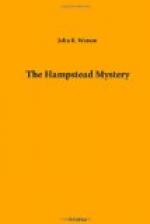The defence had contended that Hill had drawn the plan at his leisure at a time when he had access to a special quality of paper supplied to his master. If that were so, Hill’s version of how he came to draw the plan was deliberately false and had been concocted for the purpose of exculpating himself. But they would not be justified in dismissing Hill’s evidence entirely from their minds because they were satisfied he had perjured himself with regard to the plan. They would be justified, however, in viewing the rest of his evidence with some degree of distrust. Counsel for the defence had made an ingenious use of the facts that the body of the victim was fully dressed when discovered and that none of the electric lights in the house were burning. These facts lent support to the idea that the murder was committed in daylight, but they by no means established the theory as unassailable. They did not establish the innocence of the prisoner, although to some extent they told in his favour. Counsel for the prosecution had put before them several theories to account for these two facts consistent with his contention that the murder had been committed by the prisoner. The jury must give full consideration to these theories as well as to the theory of the defence. They were not called upon to say which theory was true except in so far as their opinions might be implied in the verdict they gave.
The defence, continued His Honour, was that Hill had committed the murder and had then decided to direct suspicion to the prisoner. If the jury acquitted the prisoner, their verdict would not necessarily mean that they endorsed the theory of the defence. It might mean that, but it might mean only that they were not satisfied that the prisoner had committed the murder. If the jury were convinced beyond all reasonable doubt that the prisoner had committed the murder, they must bring in a verdict of “guilty,” and if they were not satisfied they must bring in a verdict of acquittal.
The jury filed out of their apartment, and as they retired to consider their verdict the judge retired to his own room. The prisoner was removed from the dock and taken down the stairs out of sight. There was an immediate hum of voices in the court. Inspector Chippenfield approached the table and whispered to Mr. Walters. The latter nodded affirmatively and left the court room in company with Mr. Holymead. The sibilant sound of whispering voices died down after a few minutes and then began the long tedious wait for the return of the jury.
The occupants of the gallery, who had no difficulty in coming to an immediate decision on the guilt or innocence of the prisoner, could not understand what was keeping the jury away so long. They failed to understand the jury’s point of view. These gentlemen had sat in court for three days listening intently to proceedings concerning a matter in which their degree of personal interest was only a form of




